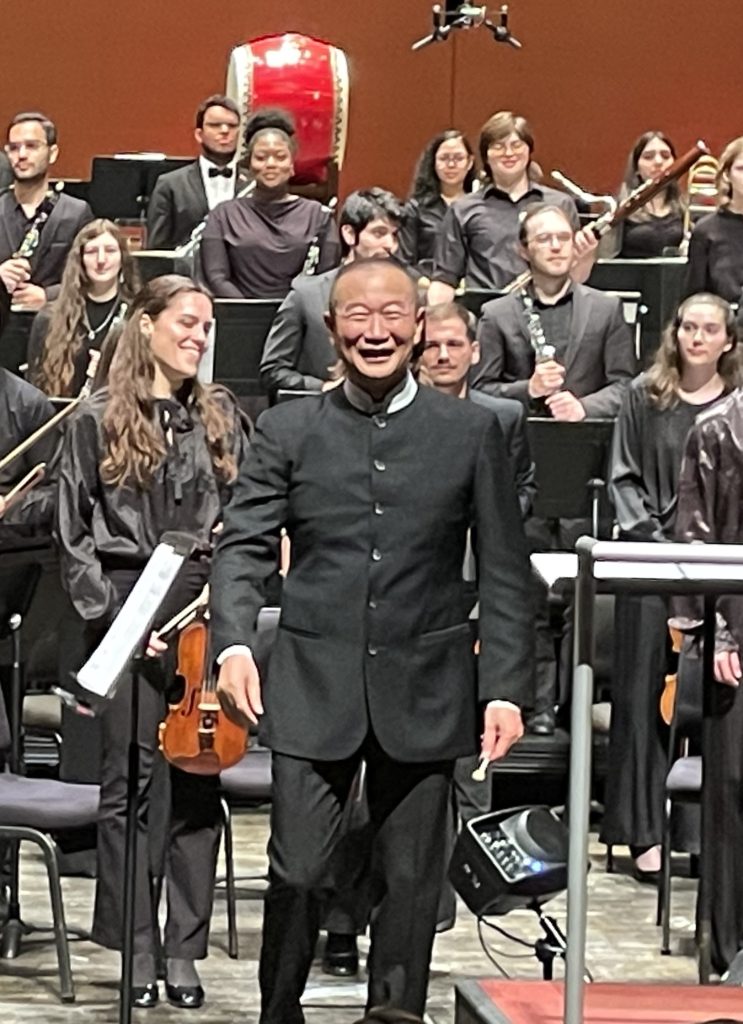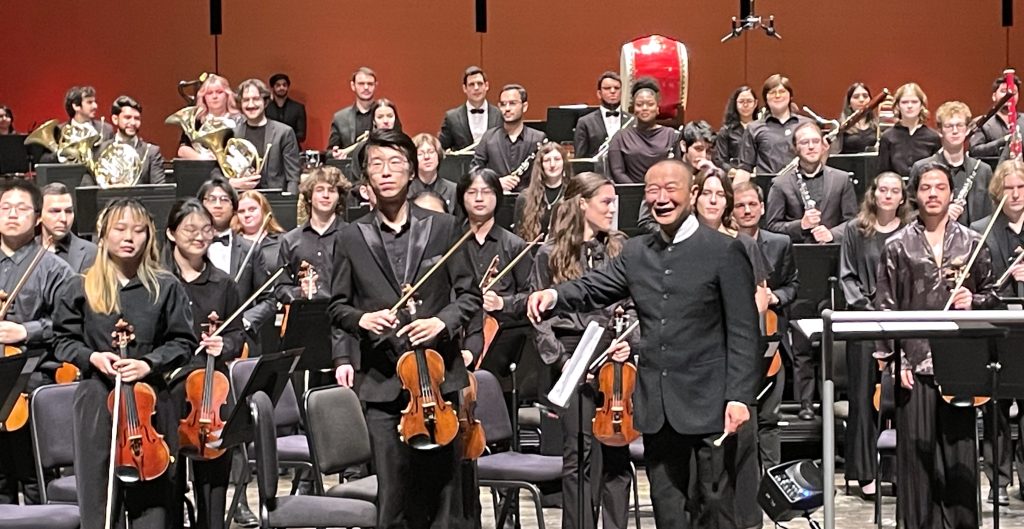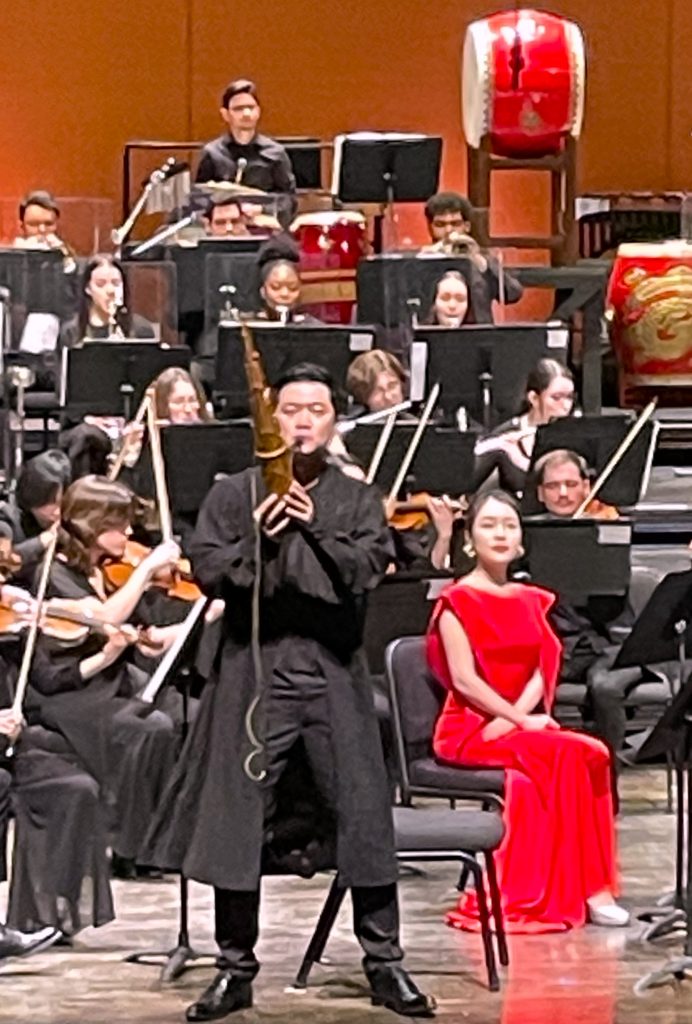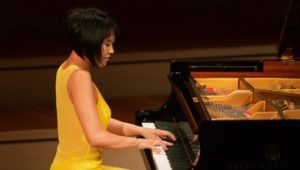
Tan Dun is a visionary composer and conductor. His work resembles a time-traveling holiday excursion into a hitherto untraveled soundscape.
The any-day-explosion Fireworks, Op. 4 (1908) by Igor Stravinsky opened the program to hint at what was to come. Here was the brief, arresting, incandescent masterpiece diamond that awed Sergei Diaghilev, the ballet impresario, to sign up young Igor and jettison ballet to the Parisian vanguard-apex of international art where it still resides (yet this was Igor’s second ballet commission from Diaghilev). Even today an enterprising, excellent conductor can dust it off with sparkling éclat, which was done last Saturday night at Sosnoff Theater to a capacity crowd.
Being merely four minutes long, the work remains an effective ear-opener, yet here it was a prescient hint at what was to come. The bitonal biting edge that Tan Dun elicited from the Bard Conservatory Orchestra put the audience on the edge of their seat for what was to come next, a four-year project that he had been working on.

An archeological dig in northern China at the Mogao Caves (with 492 Buddhist temples) discovered a 1500-hundred-year-old site of a monster concert where about 4,000 musicians once gathered to celebrate music. Five ancient instruments and scraps of music were found. Tan Dun had the idea of creating a five-part concerto showcasing these ancient instruments within the context of a modern classical orchestra. Both a modern reconstruction of the ancient instruments took longer than expected (over a ten-year period, four years in composing), and so did the composition, which was to showcase these antique instruments in the format of a serial Concerto for five (2020).
Opening with thrilling horns and robust strings accompanied by exhilarating timpani and thunderous percussion I had the image in my mind of a mighty unconquerable army marching relentlessly, accompanied by an ancient chiba (horn with player wearing a red dress) which suddenly turns to solo plangent pathos and lamentation with mourning that rebukes the mighty army. This was the first element, earth performed by Bowen Yang.
Four other instruments followed to complete the allegory of the five elements: the five-string pipa (like a lute) being water tricking over rocks, a representation of contented, domestic life, played by Han Yan; the bili (wooden recorder)being air, and the daily currency of civil life, played by Wenwen Liu with superb sophistication; the xigin (forerunner of the two-string erhu) being fire, recounting a story about romantic love, performed by Yunqi Zhu.

The climatic sheng (a double reed instrument that almost sounds like a saxophone) is the fifth element of transcendence which unites heaven and earth, played by composer and soloist Zhang Meng who emerged from the back of the audience and climbed up to the stage for the climatic finale, which was a thunderous event with timpani, drums, and violins, horns, and flutes resounding in unified music that sounded like the triumph of heavenly morality imparting to each attendee what the Greeks called catharsis, a rebirth of your orientation on earth which delivers a sense of peace and perception of life in the glow of joy. Astonishment was palpable in the air at the Intermission break!
The Song of the Nightingale (1917) by Igor Stravinsky is a symphonic poem (first performed in 1919) adapted from Stravinsky’s 1914 opera The Nightingale which tells the story of a cranky and ill Chinese Emperor who is reduced to tears by the song of a nightingale. The first movement dramatizes the swooping chromatic singing of the nightingale which impresses the Emperor; the second movement limns the gift of a mechanical singing nightingale which arrives as a gift from the Emperor of Japan and the machine drives the real nightingale away; the third movement provides the arrest of Death, yet the live nightingale gets the Emperor a reprieve; in the finale, the real nightingale flies away and the machine remains. The work (based upon a Hans Christian Anderson story) has deep, edgy dissonance wherein all eight cellos have the opportunity to excel with fury, which they did, as did Monika Dziubelski on flute and Liliána Szokol on piccolo. Stravinsky was fond of mechanical pianos because he thought they were more accurate than the average piano player.

Tan Dun noted that birds in life and music are symbols of messengers or mediators between earth and heaven in universal folklore, citing Gustav Mahler’s The Song of Earth. He thought people today were more familiar with their cell phones than birds. The first one-minute movement of Passacaglia: Secret of Wind and Birds (2024) was performed by the audience with their cell phones turned on. The sound of migrating birds (crows to me) was augmented by different seating sections, producing an impressive and haunting cacophony. Then the orchestra imitated the whooshing sound of a jet plane taking off to live and communicate with the many languages of birds.
Our first songs were bird songs modified by the invention of language about 300,000 years ago. The higher the orchestra flew, the closer we were approaching heaven. When the harps of Ashley Lim and Emelye Lobel chimed in, I realized that we all had arrived, and a raucous celebration broke out, as the orchestra performed multitudinous international languages of the divine.
Having achieved that divine reality, the climax concluded: the audience was left with the mere memory of having heard and experienced that divine musical language that we fail to achieve in ordinary speech. The trumpets especially linger in memory. Percussion shook one’s toes. The strings bound one’s heart in joyous enthrallment!
The audience demanded multiple bows—they did not want to leave the theater!

